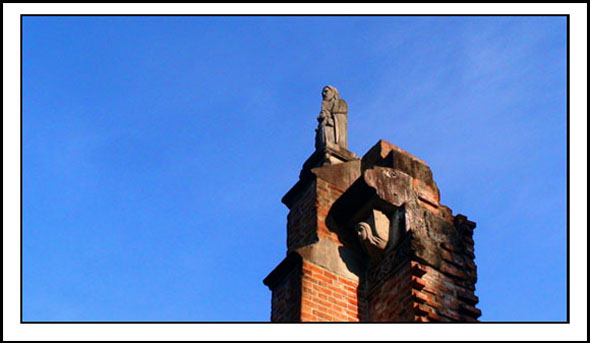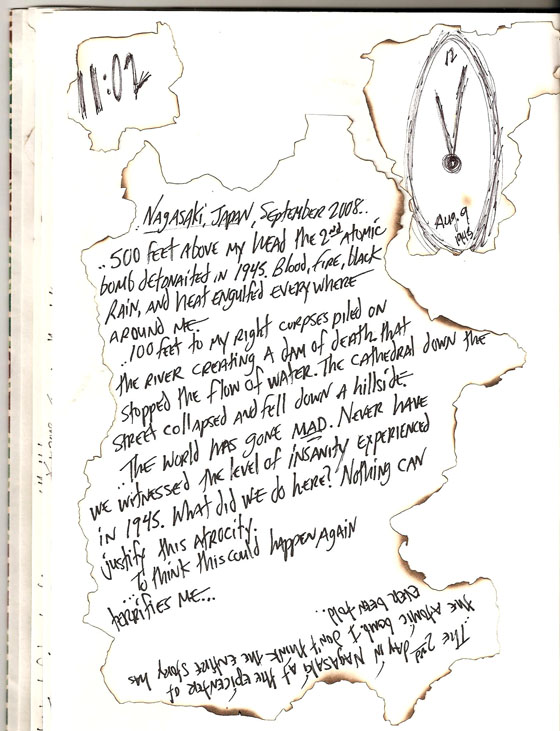Link to article about the exhibition in the Nishi Nippon newspaper.
http://www.nishinippon.co.jp/nnp/national/article/25319
Link to article about the exhibition in the Nishi Nippon newspaper.
http://www.nishinippon.co.jp/nnp/national/article/25319
..July 2013.. ..Nagasaki..
This morning I received the sad news that Mr. Senji Yamaguchi passed away outside of Nagasaki, Japan. He was 82 years old. Mr. Yamaguchi was one of the most vocal atomic bomb survivors who dedicated his life to the abolition of nuclear weapons and recognition for his fellow hibakusha (atomic bomb suvrivors).
Although he never won, he was nominated several times for the Nobel Peace Prize.
In 1982, he addressed a UN Special Session on Disarmament. Mr. Yamaguchi tirelessly traveled the world speaking to anyone who wanted to hear about the horrors of nuclear weapons.
Mr. Senji Yamaguchi would not have wanted the day of his passing to be centered around him. He would have wanted it to be a day the world remembered the hibakusha, both living and deceased, and that the atomic bombings of Hiroshima and Nagasaki not just be remembered with dates and statistics. He would have wanted it to be remembered as events which inflicted immense pain, sorrow and hatred to generations of fellow human beings that should never be repeated again.
Mr. Yamaguchi was one of the most courageous hibakusha who dedicated every moment to the abolition of nuclear weapons and recognition for his fellow hibakusha. The world is a better place because he tirelessly traveled the globe to educate people about the horrors of war, nuclear weapons and radiation.
During the last decade Mr. Yamaguchi’s body grew more fragile but his spirit did not lose the courage to make sure the catastrophic consequences of nuclear war were not passed over by the waves of time or society’s instinct for ignoring what is not desirable. His words and actions transcended the boundaries of ethnicity, culture and generational differences.
The lessons of Hiroshima and Nagasaki must be learned so that Mr. Yamaguchi’s generation is the last generation of hibakusha to have suffered from the vengeance of nuclear war. His actions are more important today because more nuclear weapons exist to destroy the world many times over and a new generation of hibakusha, suffering from radiation exposure, has been spawned due to the use of unabated nuclear power.
We should not let the message of Mr. Yamaguchi and other hibakusha be forgotten shortly after their passing. The best tribute you can give to them is to never forget the lessons of Hiroshima and Nagasaki; and not to tolerate the excuse of war being a justifiable reason to settle differences.
I photographed Mr. Yamaguchi while in Nagasaki for the From Above project. It was an unexpected opportunity that was presented to me by reporter Tetsu Mori. One of those moments I will never forget in life. He was not in good health but still had a sharp mind and understanding of current events. He had not left his home or received many visitors much during the final years of his life. I greatly appreciate the invitation from his wife, Sachiko-san. I cherished the 40 minutes photographing and speaking with him. I will never forget this moment. He is probably the most impressive person I’ve ever photographed.
From Above exhibition:
Nagasaki Peace Museum, July 9th-August 2nd, 2013
Web Site (English): www.nagasakips.com/archives/category/subscription/english
Web site (Japanese): www.nagasakips.com
Nagasaki Prefecture Museum of Art, August 8th-18th, 2013
Web Site (English): www.nagasaki-museum.jp/english/
Web Site (Japanese): www.nagasaki-museum.jp/
A few remaining copies of the book are still available at PhotoEye.com
www.photoeye.com/bookstore/citation.cfm?catalog=I1040
20130628212307 from Paule Saviano on Vimeo.
Documentary filmed by Community Media about From Above when I was photographing in Nagasaki.
From Above By Paule Saviano from paul saviano on Vimeo.
..December 2012.. ..New York..
My interview from earlier this year with talk show host John Batchelor was broadcast again on WABC Radio this weekend. It was the first US interview about FROM ABOVE, my limited edition book featuring portraits and testimonials of atomic bomb survivors and firebombing survivors from Dresden and Tokyo.
The interview can now be heard on the web at this link:
http://podfuse-dl.andomedia.com/800185/podfuse-origin.andomedia.com/citadel_origin/pods/WABC/WABC-Batchelor/jbs_102911b.mp3
The book can be purchased in the US, Japan and Europe from this links:
http://www.photoeye.com/bookstore/citation.cfm?catalog=I1040
There is only one edition of the book printed and there is a limited amount remaining.
..October 2012.. ..Nagasaki..
Earlier this year, Mainichi newspaper ran a story about atomic bomb survivor Hiroshi Matsuzoe, who I photographed in Nagasaki for my book From Above.
Last April he had an operation on his throat to removed a cancer. He lost his voice. From September, he has been training on an electronic device to speak again. He has been quite successful and on the day of the newspaper report, April 26, he was having his first lecture after the cancer operation.
‘I’m getting a little tense, ’cause I’m a bit afraid that I can’t speak well enough. But, I speak for the elimination of the nuclear weapons.’ through the machine, his voice was powerful.”
..September 2008 Nagasaki, Japan..
….500 feet above my head the 2nd atomic bomb detonated on August 9th, 1945. Blood, fire, black rain, and heat engulfed everywhere around me. For a split second the temperature at the epicenter reached 1 million degrees.
….100 feet to my right corpses piled on the river creating a dam of death that stopped the flow of water. The Urakami Cathedral a 1/2 mile down the street collapsed and fell down a hillside. Part of the tower still sits at the bottom.
The world had gone MAD. Never have we witnessed the level of insanity experienced in 1945. What did we do here? Nothing can justify this atrocity. To think this could happen again terrifies me.
..2nd day in Nagasaki at the epicenter of the atomic bomb, I don’t think the entire story has ever been told or ever will be comprehended.


..April 2012.. ..Tokyo..
From Above, my book featuring portraits of atomic bomb survivors and fire bombing survivors from Dresden and Tokyo, was reviewed by the Japan Times on April 29th, 2012.
This is a link to the review.
http://www.japantimes.co.jp/text/fb20120429a2.html
or a copy of just the text:
Sunday, April 29, 2012
Portraits and memories of those who survived the horrors of war
By GIANNI SIMONE
FROM ABOVE, by Paule Saviano. Contents Factory, 2011, 256 p.p., ¥8,000 (hardcover)
The twentieth century had, among other things, the dubious distinction of being one of the bloodiest, deadliest times in world history. Wars, genocide, mass murders, etc, aided by the best technology available at the time, were responsible for the death of hundreds of millions of people. But who were these people? And what about the survivors? History books are invaluable sources of facts and figures, but all these data, while showing the sheer scale of those tragedies, hardly convey the suffering, hopes and desperation of millions of people caught up in the fight. In other words, the ponderous weight of History all too often ends up hiding the faces of those reluctant protagonists.
Some of those heartbreaking personal stories are now aptly shown in Paule Saviano’s book, “From Above,” a collection of photo portraits and memories of Japanese and German people who have experienced the destruction of Hiroshima and Nagasaki; the fire bombings of Tokyo and Dresden; and the Bikini Incident. In the first half of this elegant big-sized book the photos are paired with fragments of memories, while in the second part short biographies are followed by the first-person tales of the atrocities those people somehow managed to overcome. All the texts are bilingual, Japanese and English.
Saviano used a Hasselblad camera with an 80mm lens to shoot his models the old-fashioned way, without any digital embellishments, in order to achieve a natural effect. At the same time, many of them were photographed from a low angle, giving them a distinguished air of solemnity. All the images are black and white and most of them only show the subject’s face and little else, so that the viewer is not distracted by the things in the background.
Some people might find Saviano’s choice of subject rather puzzling. After all, the American photographer is especially famous for chronicling the over-the-top and glamorous world of fashion models and rock stars. Indeed, those who have seen his loud color pictures are in for a big surprise. Whatever the subject, though, Saviano’s modus operandi and his ultimate goal are to capture people’s feelings and emotions. In this respect his humanistic approach is the same for both an American stripper and a Japanese 90-something granny. In this particular case, Saviano shows how all these people were united by similar tragic events, and yet they coped with their experiences in different ways. In Nagasaki he conducted the interviews at the Peace Park, while in Tokyo he actually visited each person’s house. In each case he spent hours talking to them and gaining their trust before finally shooting their portraits. Indeed, the whole project has a highly personal feeling, like a conversation between friends, or maybe old people and their inquisitive grandchild.
Even when shooting, the photographer never made his presence felt, letting instead his subjects speak for themselves. The result is a moving series of intimate portraits which are at the same time deceptively simple and very powerful. Except for some of the photos shot in Dresden, where a monument or a church hovers over the person like a symbol of History’s inescapable weight over our helpless lives, the blurred surroundings bring the faces to the foreground in all their deeply wrinkled beauty.
The stories at the back of the book tell of miraculous escapes, personal losses and survivor’s guilt. The Japanese hibakusha, for instance, remember how they had to endure rejection by their own people, and how those psychological wounds hurt them even more than nuclear radiations. In the end, though, one keeps going back to their portraits; those faraway gazes who seem to recall the past and, at the same time, cast a hopeful look at the future.
“I was saved by a miracle.
And it was a miracle too, that I could find my mother and my friends.
I was miraculously allowed to live.”
-Mr. Tsukasa Watanabe, September 2008
I received the sad news, Mr. Tsukasa Watanabe, an atomic bomb survivor that I photographed on my first trip to Nagasaki, has passed away at the age of 79. The last time I saw Mr. Watanabe was at the Nagasaki Peace Museum when From Above was exhibited in July 2010. He had been in and out of the hospital but was still in good spirits. His wife accompanied him to the exhibition to see the other hibakusha (atomic bomb survivors) portraits.
Like all the other atomic bomb survivors I have photographed, Mr. Watanabe was committed to telling the world about the importance of eliminating nuclear weapons. The compassion he demonstrated while speaking about life immediately jolted me.
He had a unique way of telling his story. He performed a one-man play about surviving the atomic bombing of Nagasaki and rescuing his mother under the debris of their destroyed home. During the last 14 years of his life Mr. Watanabe performed this play more than 100 times to audiences ranging from school children to adults.
The portrait I took of him in the courtyard of the Nagasaki Atomic Bomb Museum is a photograph that makes me feel there is hope. Mr. Watanabe’s expression immediately draws me into the image along with the mosaic background.
It was an honor to have known Mr. Watanabe. I miss him. I will always admire his sense of compassion and optimism. His voice is now silent. But I hope through this portrait his spirit will be everlasting.
Mr. Watanabe appears in this documentary about From Above, 7 minutes and 40 seconds into the video.